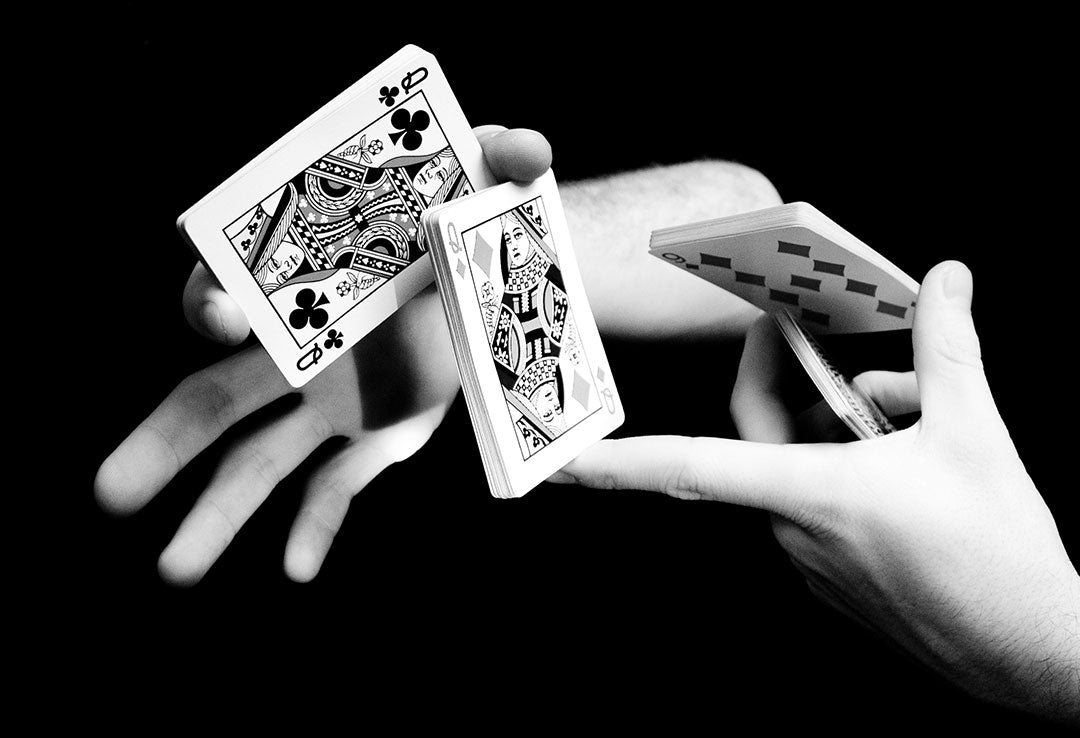
What Is Cardistry?
by Dan and Dave Buck
·
Cardistry is the most exciting, innovative, and growing skill arts in the world today. When describing cardistry to laymen, it’s often referred to as juggling with playing cards. Other skill arts commonly compared to cardistry are yo-yoing, playing kendama, and even skateboarding.
A Magical History
Cardistry evolved from the flourishes magicians use, such as a fan and card spring. These flourishes have been explained in magic books for centuries and were offered as a way to embellish a routine. Ever since, magicians have incorporated demonstrations of skill, showcasing these flourishes in their acts. Houdini’s King of Cards poster from the late 19th century illustrates some of these early developments, and perhaps inspired Cardini’s vaudeville act featuring spectacular displays of card artistry.

Although card flourishes were used by magicians throughout the 20th century, it wasn’t until the 1990s that they started to break away from magic. Publications beginning in 1982 from Bill Kalush (Harris, Paul. “Kalush’s Cut.” Magic Manuscript. December 1982 / January 1983.), through 1992 by Chris Kenner (Kenner, Chris. “Five Faces of Sybil.” Out of Control. Kaufman, 1992.) inspired some magicians to begin thinking about flourishes outside of their use in magic routines. Joey Burton, Alexander Popov, and Jerry Cestkowski were among the first to expand upon this and introduce the concept of flourishing, a type of juggling with playing cards, in the 1990s.
Around the turn of the millennium, publications from Brian Tudor (Show Off. Brian Tudor. Pascal Productions, 1997.) and Dan & Dave Buck (Pasteboard Animations. Dan & Dave Buck, 2001.) focused entirely on the art of card flourishing. Other publications quickly followed as the movement spread around the world thanks to advancements in internet streaming and the startup, YouTube.
Although cardistry sprang out of magic, its close allies are now other skill arts like playing kendama and yo-yoing. It is practiced around the world, mostly by teenagers, and continues to grow.
Cardistry has become more than an art form, it is a lifestyle. There are cardistry brands and playing cards designed especially for cardistry. There are annual conferences and organized meet-ups happening regularly, as well as numerous competitions.
A Worldwide Community
Cardistry has a flourishing community of creative and passionate artists all over the world. Annually, hundreds of cardists get together for the largest cardistry meet-up, Caridstry-Con. And daily, cardists share their creative skill with one another on Instagram. The network makes it easy to post new ideas and works in progress for immediate feedback. It’s also a great platform for discovering new cardistry moves to learn.

If you’re on Instagram, here are a few accounts to follow to get you connected: @aedijux, @annadeguzman, @anyoneww, @bestcardistalive, @cardistrytouch, @dealersgrip, @jaspas, @mattbeaudouin, @notseano, and @visualmadness.
Where to Begin
Start with a broken in deck of cards. If they’re brand new, they’ll be very slick and will slide right out of your grip. To break them in, practice shuffling the cards. This will also develop your dexterity. A pressure fan, LePaul spread, waterfall flourish, card spring and dribble are not only cardistry staples, but they also do a great job at breaking in a deck. These beginner flourishes and others are explained on video and are available to watch for free at www.artofmagic.com. Additionally, this video produced by WIRED introduces 22 levels of Cardistry:
Once your deck feels broken in or is less slippery and easier to manage, try a simple flourish like a one-handed cut, or thumb fan. Try out different moves by searching for tutorials online. There are hundreds of thousands of cardistry videos on YouTube now, so have fun exploring.
If you’re having fun, then you’re doing it right.
The Werm
The Werm is a flourish created by Dan and I and was first published in our 2004 instructional video, The Dan & Dave System. It’s great for beginners because it teaches a fundamental technique in cardistry called z-grip.
Becoming a Cardist
Here is a list of seven tips from Dan and I on how to become a cardist:
-
Always carry a deck with you and practice, practice, practice.
-
Cardistry can be overwhelming, so don’t be discouraged. There are thousands and thousands of videos, but really the only place to start is by picking up a deck and playing with it.
-
Cardistry is fun, so have fun. Enjoy the practice, and you’ll be rewarded with a new skill and source of creativity.
-
Learning the fundamentals is good, but feel free to start anywhere. There is no right or wrong way to do cardistry.
-
Learn what appeals to you and you’ll eventually develop your own unique style. From there, creating your own moves will come naturally.
-
Cardistry will be challenging at times, especially when working out a new move or trying to piece together different ideas. If you get frustrated, take a break, and work on something else, like skateboarding or kendama. Come back to it with a fresh mind and a positive attitude.
-
Experiment without expectation. When you have no expectations, things start to just happen in the fingertips and that can be very inspiring. Most of our own creations happened in these “happy accident” moments.